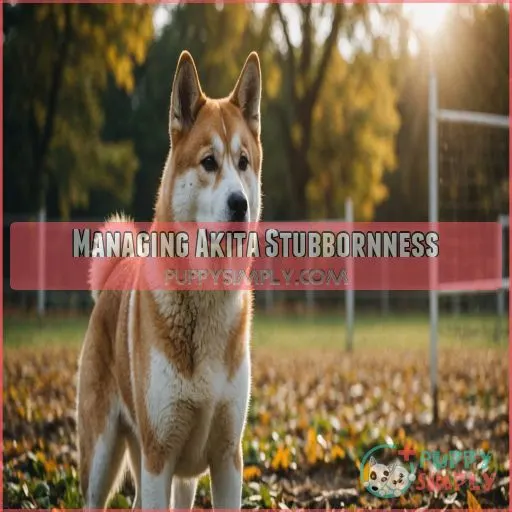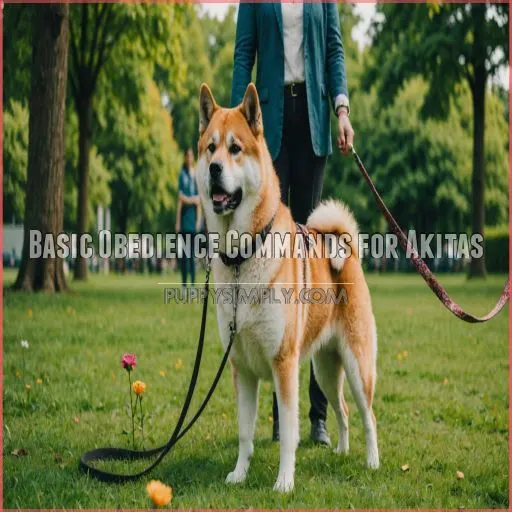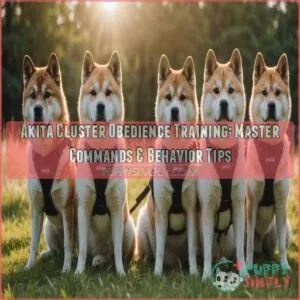This site is supported by our readers. We may earn a commission, at no cost to you, if you purchase through links.

These intelligent yet stubborn dogs thrive on reward-based techniques; they love treats and praise like kids love candy.
Don’t sweat it if they act like divas sometimes; it’s just their independence shining through.
Skip the harsh methods—they’re as useful as a chocolate teapot.
A well-exercised Akita is a happy one, so keep them moving.
Ready for more tips? Your Akita mastery journey is just getting started!
Table Of Contents
- Key Takeaways
- Akita Breed Characteristics
- Effective Training Methods for Akitas
- Socialization and Early Training
- Managing Akita Stubbornness
- Basic Obedience Commands for Akitas
- Exercise and Playtime for Akitas
- Grooming and Health Considerations
- Advanced Training and Bonding
- Frequently Asked Questions (FAQs)
- What is the best way to train an Akita?
- Can Akitas be well trained?
- Are Akita Inus hard to train?
- How to discipline an American Akita?
- How to address Akitas territorial and guarding behaviors?
- What are the best ways to curb excessive barking in Akitas?
- How can I manage an Akitas high prey drive and chasing instincts?
- What are effective techniques for Akita recall and off-leash training?
- How do I introduce an Akita to new people and animals safely?
- Conclusion
Key Takeaways
- Use positive reinforcement with your Akita, such as cheering and offering treats and praise, which work wonders. They will love the encouragement as much as kids love candy, turning training into an enjoyable bonding experience.
- Start training early with socialization to lay the groundwork. Think of it as teaching a toddler to play nice in the sandbox; your Akita will learn to thrive around others, easing that stubborn streak into submission.
- Balance exercise and mental stimulation. Your Akita is not a couch potato but more of a sprinter. Short daily walks or play sessions are like recharging batteries; they will keep your furry friend happy and fulfilled without wearing you both out.
- Forget harsh methods – they are as useful as a chocolate teapot. Consistency and patience are your best allies. Lead with clear boundaries and firm commands to steer those independent impulses into well-behaved companionship.
Akita Breed Characteristics
You’re about to start a rewarding journey with your Akita, known for their intelligence and unique temperament, which makes training both challenging and fulfilling.
These loyal giants are protective of their family but need firm boundaries and consistent exercise to keep their energy and stubbornness in check—plus, their antics will keep you entertained!
Understanding Akita Temperament
Akitas are like the CEOs of the dog world—confident and self-assured. Understanding their temperament is key to smooth sailing in your relationship.
- Akita Social Cues: They can be subtle; pay close attention.
- Dominance Drive: Be the captains, not co-pilots.
- Independence Level: Respect their space.
- Fear Response: Stay calm and reassuring.
- Prey Drive: Mind those squirrels!
Intelligence and Trainability
You’ll be delighted to learn that Akitas are highly intelligent pups, but their stubborn streak can make training a real challenge.
The key is to approach training with patience, consistency, and a focus on positive reinforcement.
Akitas thrive on mental stimulation, so get creative with training techniques that cater to their unique learning styles.
With your commitment, these regal companions can become model canine citizens.
Loyalty and Protective Nature
With their guarding instincts, Akitas have an owner-dog bond that’s tighter than a drum. They’ll protect your home with territorial behavior that would make a security system blush.
While their protective aggression can be a challenge, using operant conditioning and positive reinforcement helps.
With sound dog training methods and principles, you can channel their loyalty without ruffling feathers.
Energy Levels and Exercise Needs
While Akitas aren’t energy powerhouses, they need regular energy release.
Daily walks and short play sessions fit the bill perfectly.
Mix in some playful tug-of-war or fetch—anything to get them moving.
They’re like batteries; you must recharge them regularly for best performance.
Explore dog training methods through resources or classes to make sure you’re effectively managing their exercise.
Effective Training Methods for Akitas
Training your Akita is really important to curbing their stubborn tendencies, and positive reinforcement is your best friend in this endeavor.
With some patience and a treasure trove of tasty treats, you’ll watch them go from champions of mischief to the obedient stars of the dog park, all while avoiding those dramatic eye-rolls.
Positive Reinforcement Techniques
Positive reinforcement is the way to go with your Akita.
Reward good behaviors with tasty treats and enthusiastic praise.
This approach builds trust and a strong bond, making training an enjoyable experience for both of you.
Consistency is also vital for success.
Reward-Based Training
Imagine rewarding your Akita like encouraging a friend with compliments and chocolate.
Treats and timing go hand in hand; offer dog-friendly rewards immediately for correct actions.
It’s key to dog training methods like timing a punchline in comedy.
Look at the table below for visual guidance:
| Aspect | Example | Benefit |
|---|---|---|
| Treats | Tiny snacks | Increases motivation |
| Timing | Immediate | Reinforces behavior |
| Consistency | Regularly | Builds understanding |
Reward-based training makes dog training a rewarding journey!
Consistency and Patience
Training an Akita can feel like figuring out a maze, but consistency and patience are your trusty compass.
With a personality that’s equal parts stubborn and loyal, Akitas thrive when owners stay committed.
Embrace patience—it’s a powerful tool.
Consistent dog training strategies paired with a solid reward system can transform challenges into rewarding moments, making you the maestro of dog training tactics.
Avoiding Aversive Methods
Consistency’s your best friend in training Akitas.
Instead of using harsh methods or shock collars, focus on humane training.
Use reward-based techniques, like treats and praise.
Who needs negative reinforcement when you can have a happy Akita enthusiastic to learn?
Embrace alternatives like dog training books or articles to finesse your skills and avoid positive punishment.
Socialization and Early Training
As an Akita owner, you know these pups can be a handful.
But with early socialization and training, you can set your furry friend up for success.
From introducing new people and dogs to mastering basic obedience commands, this important stage lays the groundwork for a well-behaved Akita.
Importance of Early Socialization
In Akita puppyhood, early socialization tops the list with its benefits, like helping manage their natural stubborn streak.
With statistics showing that early exposure to different environments improves behavior, you’ll want to start straight away.
Pretty soon, your Akita will be socializing with other dogs and thriving.
Early socialization isn’t just a step—it’s a leap toward having a well-behaved companion!
Introducing New People and Dogs
As you wrap up early socialization, introducing your Akita to new people and dogs helps build trust and positive interactions.
Akita social skills can blossom with:
- Cautious introductions
- Dog park etiquette
- Structured playdates
- Rewarding calm behavior
- Monitoring body language
Basic Obedience Commands
Teaching basic commands to your Akita puppy is like laying the foundation of a powerful Wi-Fi connection.
Start simple with "sit" and "stay."
Use treats and praise—your dog training tools—to reward progress and instill discipline during walks and distraction training.
Consistency and clarity are key; they make sure your fluffy friend doesn’t file your commands under spam!
Housebreaking and Crate Training
Alongside housebreaking, crate training is a game-changer for your Akita.
Start by:
- Introducing the crate as a cozy den, not a punishment.
- Rewarding your pup for spending time in the crate.
- Gradually increasing crate time to build positive associations.
Consistency is key – stick to a potty schedule and promptly clean any accidents. With patience and positivity, you’ll have a well-trained Akita in no time!
Managing Akita Stubbornness
When training your Akita, managing their stubbornness is key; you’ll find it’s like negotiating with a furry, opinionated toddler that has its own plans.
Understand their natural independence and set clear boundaries to guide your regal companion’s behavior while keeping your sanity intact.
Understanding Akita Independence
With their Akita independence, these pups won’t fetch the paper just because you asked.
Their strong will means they’ll often test the waters.
Imagine your Akita pondering, “Do I want to do this today?”
Embrace training challenges by exploring dog training methods and dog training theories, utilizing classical conditioning techniques.
Setting Boundaries and Leadership
Akitas can challenge you with their strong-willed nature, so it’s important to establish clear boundaries early on.
Embrace your role as the pack leader by using consistent rules and firm commands.
You’ll tackle dog training challenges with confidence, and with your dog training experience growing, those "Akita dominance" moments will become nothing but tales of the past!
Positive Reinforcement for Good Behavior
Rewarding your Akita’s good behavior is key to managing their stubborn streak.
Offer tasty treats and enthusiastic praise when they obey commands or display desirable conduct.
This positive reinforcement teaches them that listening to you leads to wonderful things.
Be consistent with your rewards, and you’ll build a foundation of trust and cooperation.
Redirecting Undesirable Behavior
Think your Akita’s stubborn? They’re just testing the waters like a mischievous toddler!
To tackle issues like aggression, chewing, or leash pulling, redirect energy using positive dog training methods and gadgets like interactive toys.
If barking is their favorite solo, teach them new tunes—reward silence.
Consistent boundaries make sure you’re steering the ship, not them!
Basic Obedience Commands for Akitas
Teaching your Akita basic obedience commands like "sit," "stay," "down," and "come" is essential for their development and your peace of mind.
Model citizens might need a little bribery with treats to become model citizens!
Teaching Sit and Stay Commands
Teaching your Akita to "sit" and "stay" can seem like herding cats, but it’s completely doable with persistence and creativity.
Try these steps:
- Hand signals and treats: Time your rewards perfectly; Akitas love food-driven motivation.
- Minimize distractions: A quiet room means fewer squirrel moments.
- Positive reinforcement: Reward success and ignore slip-ups. It’s a journey, not a sprint!
Training Down and Come Commands
Next, teach your Akita the "down" and "come" commands.
For "down," hold a treat near the floor and slowly lure your pup into a lying position, rewarding when they comply.
The "come" command takes practice – start in a quiet room, say "come" and reward when they reach you.
Gradually increase distance and distractions.
Practicing Basic Commands in Public
You’ve nailed "down" and "come," so let’s hit the streets! Practicing basic commands in public is like a real-world exam for your Akita. Imagine this:
- Visit dog parks: Boost community spirit and etiquette.
- Leash control: Perfect the art of walking without tug-of-war.
- Positive reinforcement: Reward behavior that makes the dog training club jealous.
Enjoy your pup’s progress!
Gradually Increasing Distance and Distractions
Building from practicing commands in public, gradually increase distance and distractions for progression.
Picture it as slowly adding sprinkles on a sundae; each sprinkle is a new challenge.
Here’s a table to guide your steps:
| Distance (Feet) | Commands | Distractions |
|---|---|---|
| 5 | Sit | Mild |
| 10 | Stay | Moderate |
| 15 | Down | High |
| 20 | Come | Variable |
Exercise and Playtime for Akitas
When caring for an Akita, it’s really important to balance their exercise with training to keep them happy and healthy.
Your playful Akita needs regular activity, so think of them as a furry athlete who prefers short daily workouts over marathon sessions, much like a neighbor who only jogs when their favorite song comes on.
Providing Adequate Physical Activity
Akitas may not be high-energy dogs, but they still need daily physical activity to stay healthy and happy. Take your Akita on brisk walks, hikes, or jogs to meet their moderate exercise needs. Incorporate playtime with interactive toys, tug-of-war, or fetch to provide mental stimulation and strengthen your bond.
Daily Exercise Recommendations
- Aim for at least 30-60 minutes of daily exercise.
- Mix up activities to prevent boredom and keep your Akita engaged.
- Adjust exercise based on your Akita’s age, energy level, and individual needs.
Interactive Play and Mental Stimulation
Akitas thrive with interactive play and mental stimulation. Enrich their minds with puzzle toys, scent work, and agility training. It’s like a doggy crossword puzzle, engaging that clever brain!
Try hide-and-seek or fun training games, sparking creativity.
Share successes on dog training forums, blogs, and social media. Foster camaraderie and learning from fellow enthusiasts.
| Activity | Benefits | Tools Needed |
|---|---|---|
| Puzzle Toys | Mental stimulation | Puzzle toys |
| Scent Work | Enhanced senses | Scent kits |
| Agility Training | Physical and mental sync | Agility course |
| Hide-and-Seek | Fun obedience practice | Treats/toys |
Independent Play and Self-Entertainment
So, you’ve mastered interactive play! Now, encourage your Akita’s independence with self-entertainment.
Provide a variety of Akita toys to keep boredom at bay.
- Chew toys that last
- Puzzle toys for mental challenges
- Solo games enhancing skills
- Boredom busters for rainy days
- Mix of new and old toy offerings
Keep their minds sharp and tails wagging!
Balancing Exercise and Training
As you encourage independent play, remember the delicate dance of exercise and training balance. Overdoing it can turn your energetic Akita into a lazy bones!
Regular playtime with mental stimulation is key. Tailor sessions to your pup’s unique energy levels, staying in sync with dog training methods and paradigms. Keep them sharp, yet satisfied! Training, after all, evolves.
Grooming and Health Considerations
As an Akita owner, you’ll need to be prepared for some serious shedding, especially during the twice-yearly coat blowing season.
Regular grooming and health checks are a must to keep your fluffy friend looking and feeling their best.
Managing Akita Shedding and Coat Care
When "coat blowing" season hits, your Akita’s fur might seem like an endless snowstorm!
Embrace a regular brushing routine with the right grooming tools to manage those Akita coat types.
Your vacuum’s workouts might rival dog training methods!
Dial back the chaos—handle your pup’s luxurious mane with flair, all while pursuing that "best-trained Akita" headline.
Regular Grooming and Health Checks
Nothing screams "all bark and no bite" like forgetting your Akita’s grooming!
Regular grooming keeps your Akita’s coat looking sharp while managing shedding.
Pay attention to:
- Nail trimming: Avoid taps on your hardwood floors.
- Ear cleaning: Keeps infections at bay.
- Dental hygiene: Freshens breath and promotes oral health.
Make grooming a bonding affair!
Common Health Issues in Akitas
You’ve mastered grooming and health checks, but let’s talk Akita health hiccups. Hip dysplasia, bloat, and allergies are party crashers.
Eye problems and thyroid issues can join the drama.
Picture your dog training charity champion advocating for canine health! Foundation laid, now build awareness of these ailments to safeguard your loyal friend from life’s hurdles. Remember, health journeys need empathy!
Preventative Care and Nutrition
Proactively caring for your Akita’s health starts with a balanced diet suited to their unique needs. Consider:
- High-quality dog food formulated for large breeds
- Supplements to support joint health as they age
- Avoiding common allergens like beef, dairy, and wheat
- Adjusting portions as your Akita grows from puppy to adult
- Consulting your veterinarian for personalized nutrition advice
Prioritizing your Akita’s preventative care sets them up for a long, healthy life by your side.
Advanced Training and Bonding
When training your Akita, focus on building a strong bond through advanced obedience commands and fun activities.
You’ll create a partnership so solid, even stubborn moments will wane like a bad haircut growing out.
Building a Strong Bond With Your Akita
Before tackling advanced commands, nurture a strong bond.
Like dancing partners, trust and communication with your Akita are key.
Engage in shared activities and consistent training, making interactions positive.
Think of this as building a foundation—after all, Rome wasn’t built in a day!
Join a dog training social network, sharing tales of success and dog training activism.
Advanced Obedience Commands and Tricks
When advancing your Akita’s skills, you might explore agility or tracking, which aren’t just fancy terms—they’re pawsome ways to challenge their brains!
Whether it’s fetching or mastering precise heel-work, let their natural agility shine.
Always keep it playful and rewarding.
Engaging in Interactive Play and Activities
Why not try engaging your Akita in interactive play and activities to strengthen your bond?
Fetch, tug-of-war, and puzzle toys can provide mental stimulation and quality time together.
Get creative – you might even teach your pup a few fun tricks!
Playtime reinforces positive behaviors and keeps your Akita happy and healthy.
Strengthening Your Relationship With Your Akita
Bonding with your Akita deepens through playful communication and consistent training.
Imagine your Akita as a teammate, keen to master goals together.
Reward patience with trust-building activities, like gentle grooming or sharing a quiet moment.
Keep training sessions fun and engaging.
With dedication and empathy, your Akita will become not just a loyal companion, but a true partner in crime.
Frequently Asked Questions (FAQs)
What is the best way to train an Akita?
Training an Akita feels like taming a whirlwind! Start with positive reinforcement to harness their strong-willed nature. Use treats and praise.
Keep sessions short, consistent, and distraction-free.
Early socialization is key. Enjoy every challenge!
Can Akitas be well trained?
Absolutely, Akitas can be well trained!
Their intelligence and loyalty make them keen learners.
Use positive reinforcement consistently and patiently.
With persistence, you’ll turn this "I do what I want" breed into a regal, obedient companion.
Are Akita Inus hard to train?
Training Akita Inus isn’t exactly a walk in the park. They’re smart but strong-willed.
Early socialization, consistent positive reinforcement, and patience are key.
Don’t be afraid to consult a professional if they’re giving you the side-eye!
How to discipline an American Akita?
You’ll need patience and consistency when disciplining an Akita.
Positive reinforcement works best – reward good behavior with treats and praise.
Avoid harsh punishments, as they can damage your bond and make the dog more stubborn.
Stay calm, be the leader, and your Akita will thrive.
How to address Akitas territorial and guarding behaviors?
Taming Akita’s territorial instincts requires early socialization.
Make introductions slowly; they’re not massive fans of uninvited guests.
Positive reinforcement helps—praise and treats work wonders.
What are the best ways to curb excessive barking in Akitas?
Got a barking Akita? Time to turn down the volume!
Use positive reinforcement to reward quiet moments, keep training sessions short and sweet, and make sure they get plenty of exercise.
A tired Akita is a quieter Akita!
How can I manage an Akitas high prey drive and chasing instincts?
Picture your Akita as a wild explorer in your backyard.
Use a long leash to guide adventures.
Engage its sharp mind with scent games, and reward calm behavior with treats, teaching your Akita control over its instincts.
What are effective techniques for Akita recall and off-leash training?
You’ll need to start recall training early and make it a fun game.
Use high-value treats, gradually increase distance, and practice in distracting environments.
Consistency and patience are key to mastering off-leash control with your Akita.
How do I introduce an Akita to new people and animals safely?
Introduce your Akita to new people and animals by ensuring a calm setting.
Arm yourself with tasty treats for positive reinforcement, and encourage the “sit” command before interactions.
This technique sets everyone up for wagging success.
Conclusion
Starting your journey to master the best training methods for Akita cluster dogs is like piecing together a compelling puzzle of patience and reward.
As the maestro, you’ll blend structure, positivity, and a dash of humor to nurture a well-behaved Akita.
Remember that while Akitas can be as obstinate as a mule with a sweet tooth, understanding their loyalty and independence is key.
With these tools, you can foster a happy, healthy, and obedient companion.














